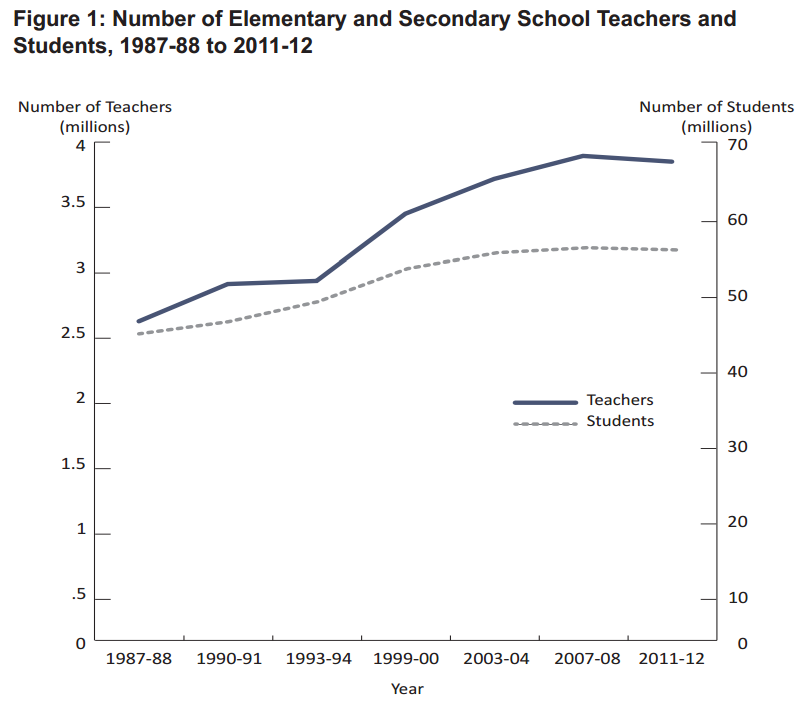Trends in US Teaching Force
Ingersoll, Merrill and Stuckey from the Consortium for Policy Research in Education, University of Pennsylvania have looked closely at data on teachers in the United States to explore what changes have occurred within the teaching force during the past 25 years. In their report, Seven Trends: The Transformation of the Teaching Force, they pointed out the following: Teachers in 2012 compared to teachers in 1987 are larger in numbers, younger, less experienced, more female, more diverse by ethnicity, similar in academic abilities, and are less likely to stay teaching. Here are some of the graphs that support the above trends (copied from the original report):
The number of teachers has grown faster than students. The higher increase in the number of teachers can be attributed to a variety of reasons such as reduction in classroom sizes, special education, english language learners, and preschool education.
The above graph actually captures critical turning points in time. The average age of a teacher may have indeed increased from 1987 to 2007, but this trend would now reverse. In 1987, the age distribution is much narrower with a mode (most common age) of 41. In 2007, the distribution became much broader with a new mode at 55. But in 2011, the mode has dramatically dropped to 30. The younger age, of course, correlates with teachers in 2011 having less experience than those in 1987:
Another trend that is continuing is that more and more teachers are female:
It is interesting to compare the above trends with those in the Philippines.
In the United States, during 1987-2011, the number of teachers grew twice as fast as the students. In the Philippines, using the period 2004 to 2010, the number of teachers has grown by 11.4%, which is not that large compared to how fast the number of pupils has increased: 8.2%. Thus, there is no surprise that in the Philippines the pupil to teacher ratio has remained very high.
With regard to age, the distribution for teachers is obviously grayer:
Nearly half of elementary school teachers are more than 50 years old, with 16% above 60 in 2009.
There are similarities and there are differences. But one data point that applies only to the Philippines is shown in the following table:
The United States is the top destination of Philippine teachers deployed abroad. It is useful to look at these trends. These provide meaningful snapshots of the teaching force of a country. These can either raise serious concerns or comfort....
The number of teachers has grown faster than students. The higher increase in the number of teachers can be attributed to a variety of reasons such as reduction in classroom sizes, special education, english language learners, and preschool education.
The above graph actually captures critical turning points in time. The average age of a teacher may have indeed increased from 1987 to 2007, but this trend would now reverse. In 1987, the age distribution is much narrower with a mode (most common age) of 41. In 2007, the distribution became much broader with a new mode at 55. But in 2011, the mode has dramatically dropped to 30. The younger age, of course, correlates with teachers in 2011 having less experience than those in 1987:
Another trend that is continuing is that more and more teachers are female:
It is interesting to compare the above trends with those in the Philippines.
In the United States, during 1987-2011, the number of teachers grew twice as fast as the students. In the Philippines, using the period 2004 to 2010, the number of teachers has grown by 11.4%, which is not that large compared to how fast the number of pupils has increased: 8.2%. Thus, there is no surprise that in the Philippines the pupil to teacher ratio has remained very high.
With regard to age, the distribution for teachers is obviously grayer:
Nearly half of elementary school teachers are more than 50 years old, with 16% above 60 in 2009.
There are similarities and there are differences. But one data point that applies only to the Philippines is shown in the following table:






Comments
Post a Comment